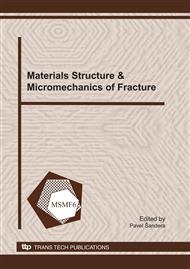p.463
p.467
p.471
p.475
p.479
p.483
p.487
p.491
p.495
Mechanical Analysis of Multi-Textural Rocks (Brecciated Dolostones and Limestones): A New Micro-Compression Test for Rocks
Abstract:
Both strength and elastic modulus of rocks are usually determined by compression testing at the mesoscopic scale (UNE-EN 1926; ASTMD 3148-96), and the values obtained are representative of homogeneous rocks. However, heterogeneous and texturally complex rocks show a broad dispersion range and their strength and elastic modulus depend on the presence of different textures and their mechanical properties. The aim of this study was to quantify the mechanical behaviour of these textures individually in order to understand the strength and elasticity of the whole rock. Four varieties of brecciated carbonates (limestones and dolostones) were studied. These rocks have a very complex fabric, presenting a dense network of fractures and clasts between fractures (mm-cm size). The fractures are completely filled with calcite cement, and clasts can have one or two different textures, each presenting differences in crystal size, mineralogy and porosity percentage and type. Samples measuring 4x4x4 mm were obtained in order to test each texture individually. These micro-samples were tested in a uniaxial compression press and the stress-strain curve was recorded. In addition, mean strength and Young’s moduli were calculated for each texture. Results show that textures with a larger crystal size, lower porosity and intercrystalline porosity had the lowest strength and were the least elastic.
Info:
Periodical:
Pages:
479-482
Citation:
Online since:
January 2011
Keywords:
Price:
Сopyright:
© 2011 Trans Tech Publications Ltd. All Rights Reserved
Share:
Citation:


